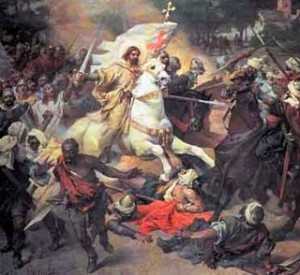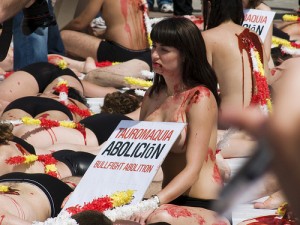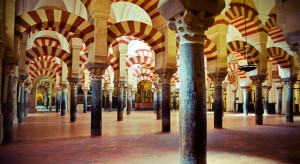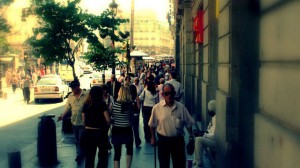Ever since her now deceased husband, German industrialist Baron Hans Heinrich Thyssen, sold his unrivalled art collection to the Spanish state in 1992, Carmen Cervera has rarely been out of the headlines, her not-quite rags, but certainly to riches, story, combining a glamour, art, and a good old fashioned family feud providing the gossip writers with plenty of copy. Her latest appearance in the media came after she decided to sell Constable’s 'The Lock' earlier this month. The early 19th century landscape is now one of the most expensive British paintings ever sold and went under the hammer for more than €27 million. The former beauty queen — she was Miss Spain in 1961 — says she had … [Read more...] about Profile: The incombustible Carmen Cervera Thyssen
spain culture
Celebrating Santiago’s ever-changing afterlife
When Spanish troops arrived in Iraq in 2004 to help the allied occupation of the country, they looked much like any other force of Western troops, wearing uniform and wielding guns. But a closer look showed them wearing something that spoke very clearly of their Spanish identity and history: the red cross of Santiago Matamoros, or Saint James the Moorslayer. It was a crass gesture, given the Muslim enemy they were going to fight, but Spain and particularly its military have used St James as a symbol of inspiration in different guises for the last 1,200 years. July 25 is the feast day of Spain’s patron saint, when he and the extravagant legend surrounding his afterlife are … [Read more...] about Celebrating Santiago’s ever-changing afterlife
Bullfighting: Fighting for its future
Bullfighting has been banned in Spain's northeastern region of Catalonia, but travel south and you find that the tradition and support for bullfighting grows. Seville is no exception. And those involved in bullfighting, an event that finds its origins in the 18th century, recognize the battle they face. Nonetheless, they remain confident that the tradition will continue to thrive in the country’s thousands of bullrings. "In Andalusia, no. Short term, medium term and long term, no,” says bullfighting journalist Álvaro R. del Moral regarding the possible prohibition of bullfights in Southern Spain. “Here things are very clear.” If Del Moral’s prediction is to prove accurate, interest … [Read more...] about Bullfighting: Fighting for its future
Bullfighting in the political ring
Rich in tradition and explicit in diversity, Spain is a country constantly suffering an identity crisis. Liberalism and democracy were born along with nationalism and separatism after Francisco Franco’s death in 1975. While Spain’s official language is Spanish, a handful of regional languages are spoken across the country. In the northeastern region of Catalonia, people speak Catalan. Citizens from the southern region of Andalusia speak Spanish. A citizen from Seville might not be able to read Avui (a Barcelona-based newspaper printed in Catalan), but when the Catalan government passed a law last summer to close the only remaining bullring in Barcelona in 2012, the bullfighting … [Read more...] about Bullfighting in the political ring
Córdoba
Andalusia has a handful of candidates for this list, not least Granada and Seville. But the former capital of the Islamic caliphate comes out on top for several reasons. The Mezquita is the obvious one: a massive, labyrinthine mosque that is beautiful despite having a Catholic cathedral dumped on top of it. In addition, central Córdoba has maintained its appeal despite the brutal urban development raging around it, and what’s better than a wander around the Jewish quarter after a plate of rabo de toro? … [Read more...] about Córdoba
Barcelona
An obvious choice for obvious reasons: the Sagrada Familia temple, the Gaudí park, Montjuïc, the finest football team on earth, more Gaudí, and a beautiful, freakish coastal skyline. But beyond the evident draws there is plenty more. The Ramblas may be a haven for pickpockets and boozy foreigners and have all the charm of a German autobahn, but just round the corner is the smaller, more pleasant Rambla del Raval. The most rewarding parts of Barcelona are where the visitors rarely tread. … [Read more...] about Barcelona
Vigo
Many will raise an eyebrow at the sight of this Galician industrial town being included and will argue that its more fêted rivals/neighbours Santiago de Compostela and A Coruña both make stronger cases. But anyone who has gazed across the Ría de Vigo to Cangas after strolling the length of this city’s immaculately maintained promenade will understand. There’s not much in particular to see or do in Vigo, but that’s part of its appeal: it’s not trying to pander to anyone. Cheap accommodation, a maze of knee-aching hills and stupendous octopus seal the argument. … [Read more...] about Vigo
Bilbao
Not so long ago, Bilbao was seen as an unattractive place, known for its industry and the dark-suited bodyguards who escorted public figures threatened by ETA around town. But today the city is perhaps the most obvious example of “modern Spain”. Much of its regeneration is due to Frank Gehry’s angled, shining Guggenheim Museum, perched on the bank of the Nervión river. The building boosted the economy, draws millions of tourists and has given the city a renewed confidence and sense of identity. Also, where else can you find such an artful giant spider? … [Read more...] about Bilbao
Madrid
When it comes to sights, the capital can’t compete with Barcelona. The Almudena Cathedral is pretty ugly, there’s no waterway to speak of, and the skyline is basically four massive, incongruous towers plonked at one end of town. But the point about Madrid is that you don’t see it, you live it. Go for a few drinks in Lavapiés, flea-market shopping in La Latina’s Rastro, or an autumnal walk through the Retiro, and tell me you’d rather be in Barcelona, queuing three hours to get into a cathedral that hasn’t even been finished… … [Read more...] about Madrid








